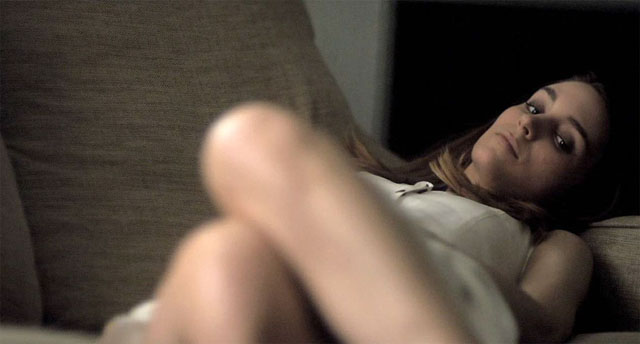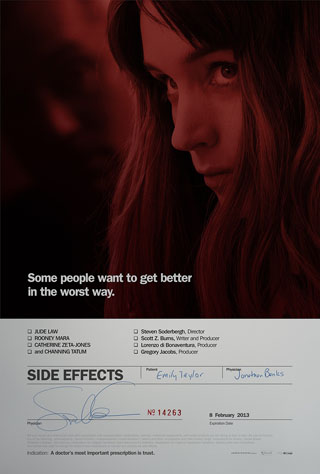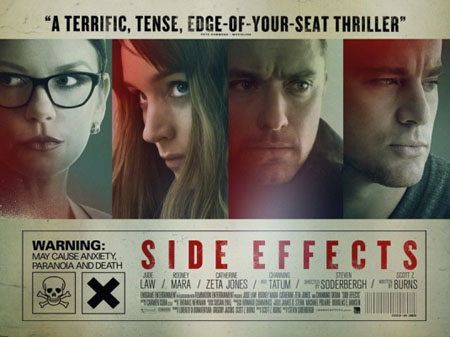“If Side Effects, an immensely pleasurable thriller centering around psychotropic drugs, really is Steven Soderbergh’s final big-screen film, as the director claims it will be, then he has peaked in the Valley of the Dolls,” writes Melissa Anderson in the Voice. “Scripted by Scott Z. Burns, who also wrote the screenplay for Soderbergh’s Contagion (2011), Side Effects shares, at least at first, the earlier movie’s icy fury over the corruption of the medical profession. Psychiatrists dispense SSRIs and SNRIs like Pez candies and are wooed by Big Pharma reps over lunch at Le Cirque. Yet when this initially pointed critique of our quick-fix, highly medicated era becomes, in its final third, a twisty genre exercise—filled with double-crosses, blouses ripped in the heat of passion, and hidden microphones—it doesn’t lessen the movie’s punch.”
“The premise is patently yet intriguingly ridiculous,” writes Keith Uhlich in Time Out New York. “Emily Taylor (Rooney Mara)… is the eagerly devoted wife to Martin (Channing Tatum), a Wall Street broker who’s just finished up an insider-trading jail stint. She puts on a brave face for her hubby’s homecoming. But there’s trouble lurking beneath Emily’s cool exterior—a suicidal revulsion for her upended life that comes to light after she impulsively crashes her car into a parking-garage wall (a beautifully tense scene). This is how she meets Dr. Jonathan Banks (Jude Law), a psychologist who begins treating Emily with the kind of creepy detachment that seems equal parts empathetic and condescending. Their early sessions are very by the book until Banks contacts Emily’s former shrink, Dr. Victoria Siebert (Catherine Zeta-Jones), who recommends he prescribe his patient a new antidepressant called Ablixa. Then things start getting… odd.”
“Little more should be said about the plot, which at some point takes a sharp turn into the noir terrain Soderbergh plumbed in his 1995 Criss Cross remake, Underneath.” David Edelstein in New York: “The movie’s great unknowable is Mara, an actress who seems most in her element at her most subterranean. Her face is a mask (Eyes Without a Face swims to mind); there’s an instant’s hesitation between thought and speech, as if her words have to travel up through water to the surface. You can study that chiseled face with its pale, glassy peepers and feel no closer to understanding her, but you get the feeling there’s something down there. Figuring out what is half the fun.”
“Through his clever use of confined spaces and reflective surfaces, Soderbergh thrills in keying us to Emily’s off-kilter state of mind,” writes Ed Gonzalez in Slant, “but Side Effects would be boring if it merely struck Contagion‘s alarmist stance and stuck to it. The film flirts with being a hysteric cautionary tale about Big Pharma’s thuggishness only to reveal itself as a rebuke to the very cynicism about public health that Contagion so flagrantly peddles.”
“If Side Effects isn’t the study of our routinely addled and compromised pharma-world that you might first anticipate, Soderbergh does tap into a long-established cinematic obsession with the psychiatric,” writes Nicolas Rapold at the L. “Whether it was the Freudian exposition that seemed to sweep Hollywood after WWII, or amnesia-driven films noir and melodramas, screenwriters and directors grew fascinated with what might be called ‘the break’: the narrative moment when all bets are off, and the reason isn’t reason, God, or love, but something crazier and unplumbed. For Soderbergh—and again I tread lightly simply to preserve some of the film’s did-I-miss-something plotting—anti-depressants and their ilk clearly hold an attraction as legally mind-altering drugs: it’s a socially sanctioned method for chemical experimentation on your brain that remains rather less precisely understood (or carefully prescribed) than you might expect.”
More from Justin Chang (Variety), Tim Grierson (Screen), Eric Kohn (Indiewire, B+), Todd McCarthy (Hollywood Reporter), and Drew Taylor (Playlist, B).
Interviews with Soderbergh are nearly always lively, but especially these days, now that he’s on the next-to-last leg of his farewell tour (Behind the Candelabra, his Liberace movie with Michael Douglas and Matt Damon airs on HBO in May). You’ll remember Mary Kaye Schilling‘s wide-ranging talk with Soderbergh for New York. In the Voice this week, Scott Foundas finds Burns all but prodding Soderbergh to consider more non-theatrical feature work.
And Nigel M. Smith‘s conversation at Indiewire: “Yesterday, we ran the first part of our whopping 45 minute (per his request) interview with the director in anticipation of the film’s release, in which he discussed his imminent Hollywood departure, his friendship with fellow Mara admirer David Fincher, his upcoming HBO biopic Behind the Candelabra, and whether he’d ever consider showrunning a TV series. In this second installment, Soderbergh reveals which genre he wishes he had tackled, why he chose not to return to Magic Mike 2, his take on the cut he saw of Paul Schrader’s Hollywood satire The Canyons, and details on his upcoming move to Broadway with his Side Effects star Catherine Zeta-Jones.”
“What is Steven Soderbergh’s best film?” asks Matt Singer, and the Criticwire network responds. Sean Axmaker offers eleven answers at MSN.
Marlow Stern profiles Mara for Newsweek (NewsBeast?), and for Salon, Daniel D’Addario talks with Sasha Bardey, a forensic psychiatrist and the medical adviser on Side Effects.
Updates, 2/7: “Over the last three decades, Steven Soderbergh has been the most versatile, not to mention hyperactive, of Hollywood directors and, as befits the movie that he has said will be his swan song, Side Effects showcases much of what the just 50-year-old filmmaker does best,” writes J. Hoberman at Artinfo. “Without him, his only two peers, Richard Linklater and Gus Van Sant, will be more or less out there by themselves.”
In the New York Times, A.O. Scott finds Side Effects to be “less a summing up than a greatest-hits package, reminding viewers of some of the things that this protean director has done well in recent years. (In addition to casting Channing Tatum, that is.) It has a clammy medical anxiety that recalls Contagion, hints of the corporate shenanigans of The Informant!, the do-gooder convictions of Erin Brockovich and an eye for high-end New York environments that defined The Girlfriend Experience. What these films have in common—and we can add Magic Mike and even the Ocean’s Eleven pictures to the list—is a critical interest in the intimate effects of a capitalist economy that bundles ethical risks along with material comforts and opportunities for self-making.”
“26 features and, for years, he’s been his own camera operator, cinematographer (‘Peter Andrews’) and editor (‘Mary Ann Bernard’),” notes Ray Pride at Newcity Film. “To argue that any movie is a reflection of its process is reductionist, yes, but in the case of Soderbergh’s recent exit interviews—bold yet affirmative, sometimes even strident—Side Effects is a well of perhaps inadvertent self-reflection, down to the smallest details.”
More from Steve Erickson (Nashville Scene), Andrew O’Hehir (Salon), David Schmader (Stranger), Dana Stevens (Slate), and Scott Tobias (AV Club, B+).
At the Playlist, Rodrigo Perez interviews Soderbergh and Drew Taylor talks with Burns, as does Indiewire‘s Nigel M. Smith.
Updates, 2/10: “If the baseline for defining a thriller is that it provide thrills, and for a mystery, that it tantalize with unexpected revelations, then Side Effects… meets those criteria amply,” writes the New Yorker‘s Richard Brody.
Time‘s Richard Corliss: “Side Effects virtually demands a three-word review: Just see it.”
More from Robert Horton (Herald), Eric D. Snider (Twitch), and Kenneth Turan (Los Angles Times). And Ignatiy Vishnevetsky interviews Soderbergh for the Notebook.
Updates, 2/13: Vadim Rizov for Cinema Scope:
Where in Haywire (2011), Contagion (2011), and Magic Mike (2012), Soderbergh ostentatiously flattened and abstracted space into gleaming, sharp-angled quadrilaterals, in Side Effects he mostly preserves pre-existing depth and dimensions—a relative visual sobriety that belies a story heavy on cartoonish conspiracy and improbably knotty plot twists…. In broad outline, Side Effects‘ wholesale condemnation of a country on the take on every level is reminiscent of a jeremiad like Fritz Lang‘s While the City Sleeps (1956), in which journalists, police and murderers are all revealed as equally egregious violators of the social contract. But the po-faced ludicrousness of its central conspiracy simultaneously invalidates it as either scabrous social critique or disposable, cheerfully sordid thriller. Taking little glee in his film’s ultimately tawdry transgressions and evincing none of Lang’s grimly acidulous pleasure at the spectacle of avaricious human nature remorselessly exposed, Soderbergh in Side Effects is so angry that he not only loses sight of his target, but finally loses his grip on that pleasurable efficiency which had come to be his films’ lowest common denominator.
“Few other contemporary American directors are this coolly playful with genre, as exacting with stars, or capable of grounding a faintly preposterous entertainment in the modern world,” writes Tim Robey in the Telegraph.
More, in Spanish, from Diego Lerer.
For news and tips throughout the day every day, follow @KeyframeDaily on Twitter and/or the RSS feed. Get Keyframe Daily in your inbox by signing in at fandor.com/daily.






